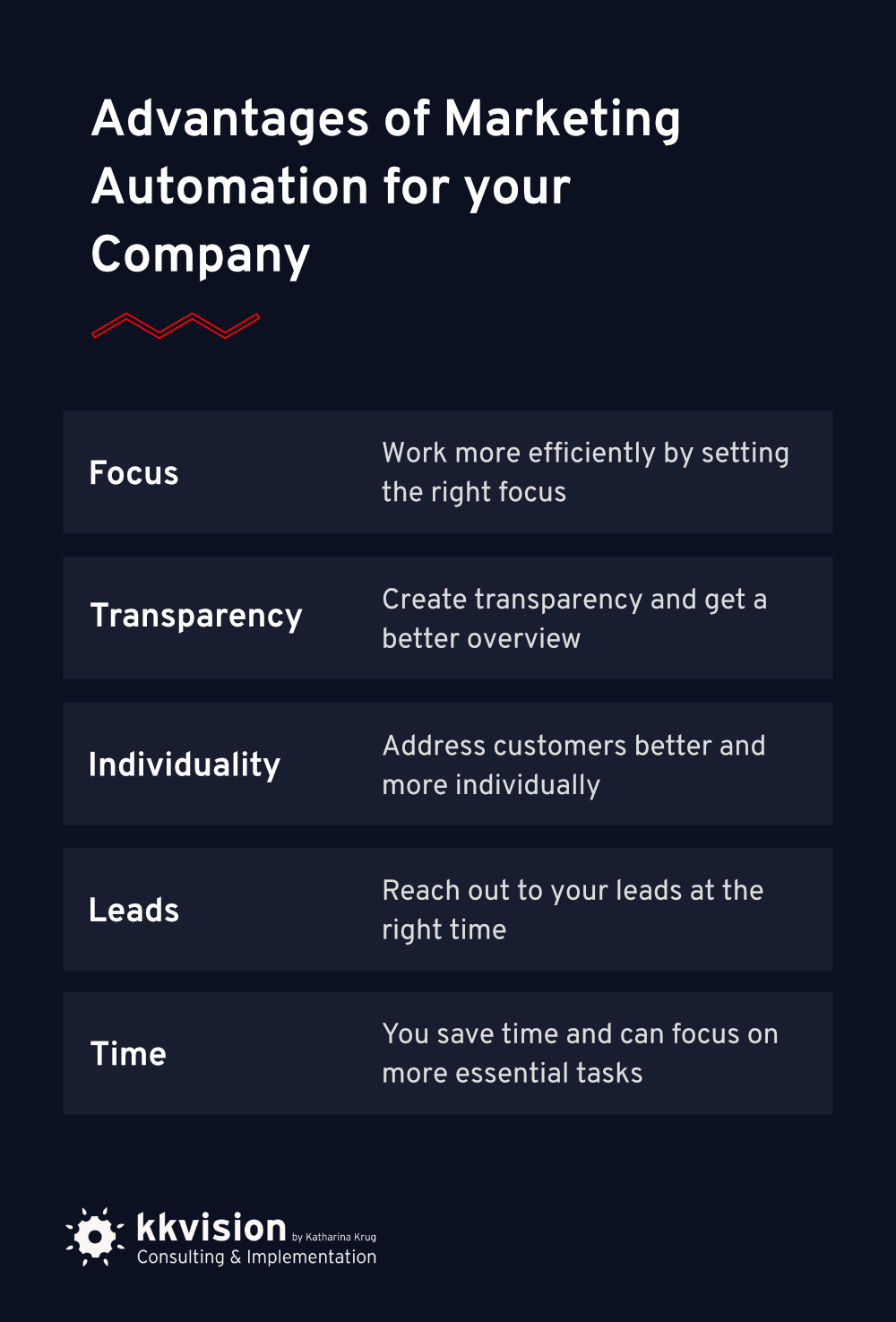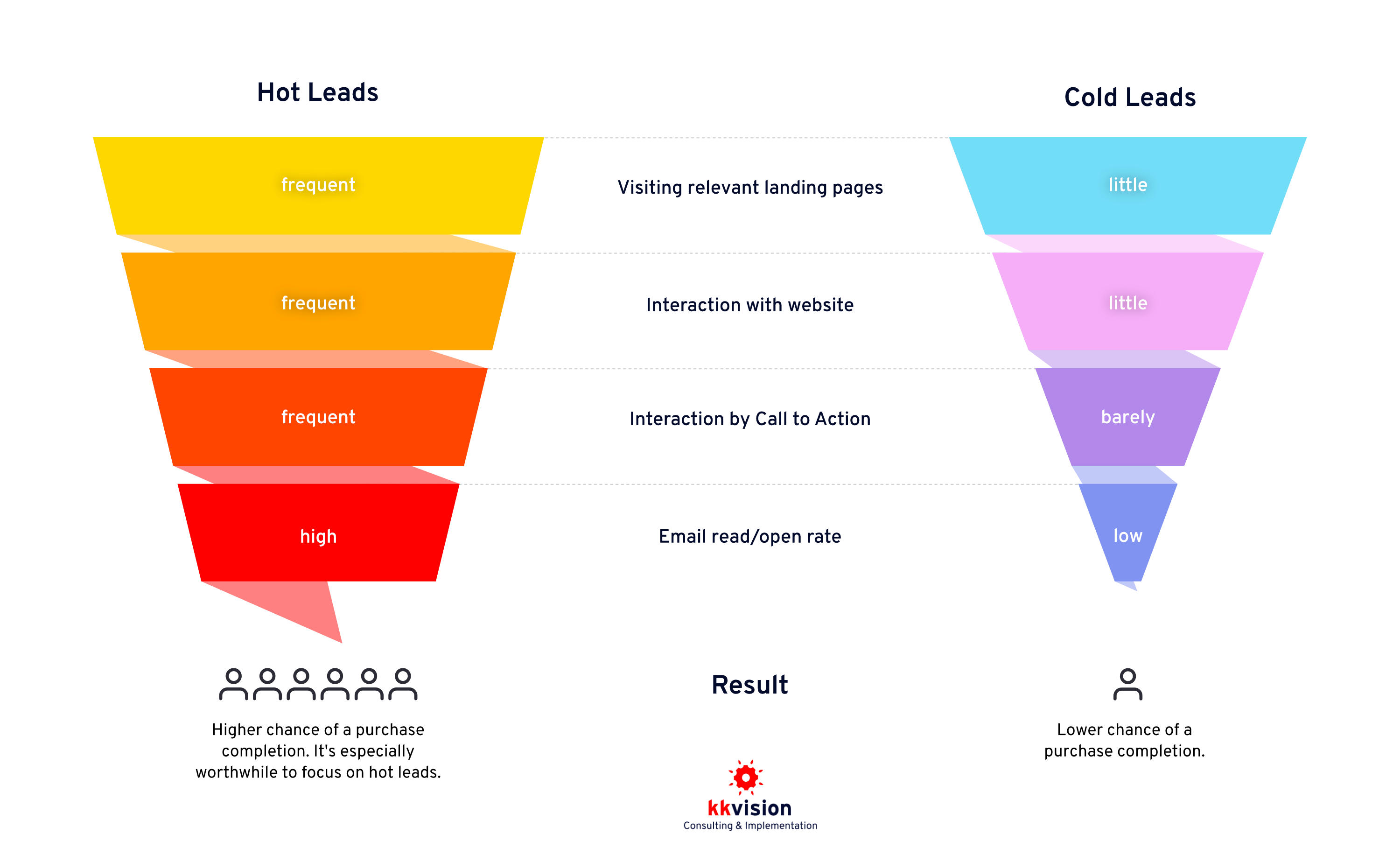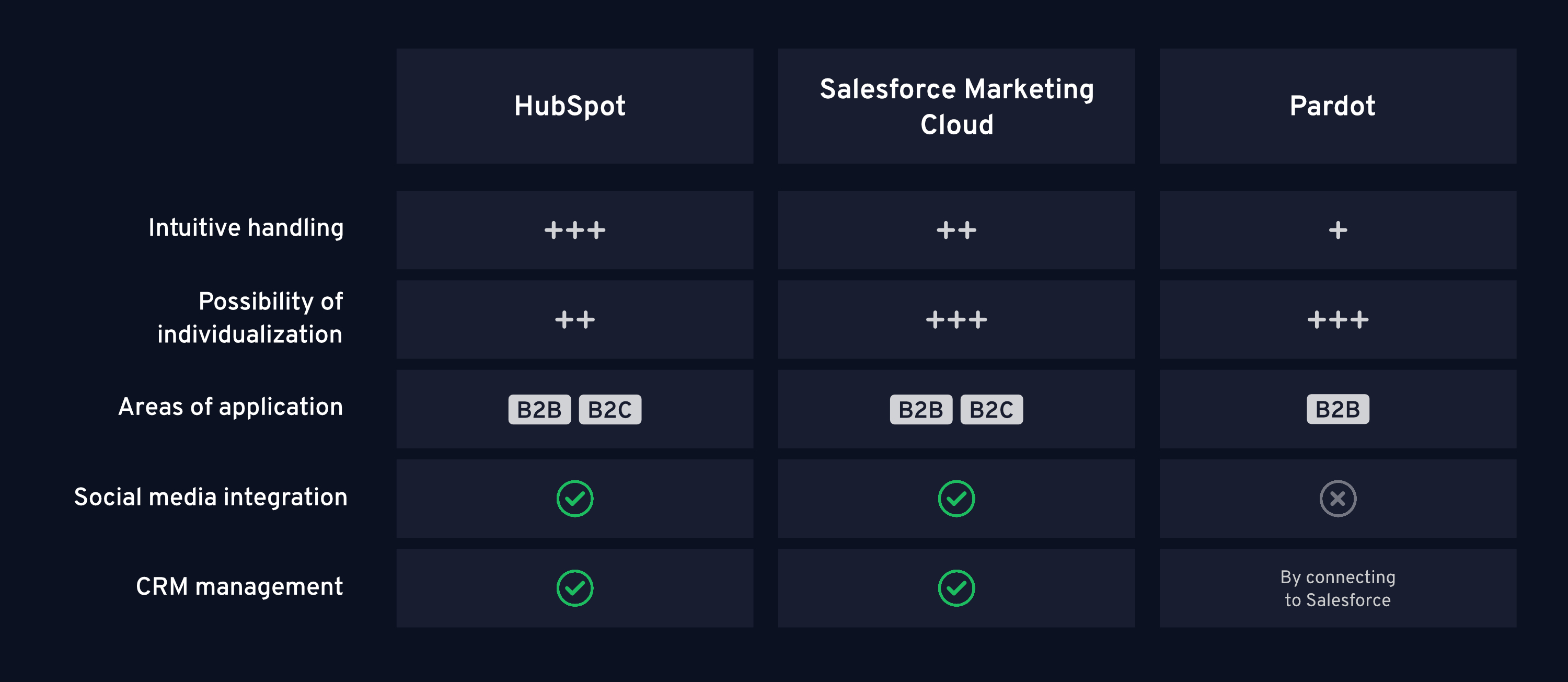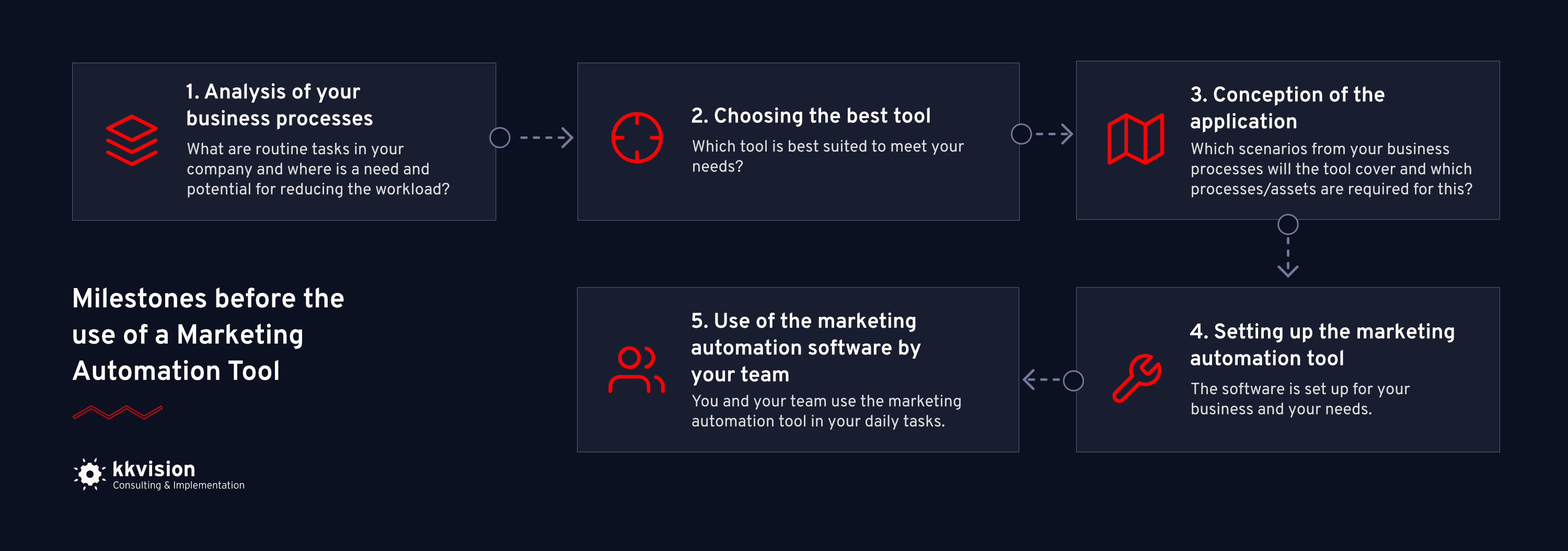
Author
Katharina Krug
CEO & Founder
DE
EN
DE
EN

Author
CEO & Founder
Good marketing is essential, regardless of the size and industry of a company. However, planning and executing marketing activities is a time-consuming undertaking. This is even greater if you want to be individualized and targeted.
Good marketing is essential, regardless of the size and industry of a company. However, planning and executing marketing activities is a time-consuming undertaking. This is even greater if you want to be individualized and targeted.
Similar to sales automation, so-called marketing automation can bring enormous time support for you and your team. They carry out your marketing activities, such as sending e-mails, automatically, even in large quantities and individualized depending on the contact.
From my many years of experience in the field of marketing automation, I know how enormously facilitating the use of marketing automation can be for companies and not only facilitate the process for marketing employees, but also optimize it. In this article, I would like to give you an overview of the possibilities for this - regardless of whether marketing automation is something completely new for you or you already work with it.
Marketing automation offers you and your team a great deal of relief in daily tasks and also offers the potential to optimize your marketing activities. Marketing automation tools offer you powerful and comprehensive tools for this. As the founder of the marketing automation agency kkvision, I will give you an overview of how these tools can be used, current trends in marketing automation, and what should be considered when using them.
There is specific software for setting up and using marketing automation, so-called Marketing Automation Tools.
There are not only a variety of different tools, but also functionalities that these marketing automation tools offer. It can be difficult to keep track of things. In this article I will give you an overview of what marketing automation tools are, what advantages they bring and who can best benefit from them.
.png?width=2200&height=967&name=kk-MarketingAutomationTools-Taschenmesser-EN-v2%20(1).png)
In terms of their functionalities, marketing automation tools can be described as multi-functional all-rounder tools. They offer a variety of different functions that interact and complement each other to cover the marketing process in a variety of ways. E-mail automation is essential here. At the same time, there is extensive lead and contact management as well as lead scoring, which classifies the potential of these leads for your company.
Furthermore, automated processes can be controlled by process automation, so-called workflows. You can easily create website forms or entire landing pages. And extensive reporting and analysis tools give you information, for example, about where your leads come from, how successful individual campaigns are or which products are currently in particularly high demand.
The use of a marketing automation platform brings you advantages in many ways. These include in particular:
When used properly, a marketing automation tool can save you and your team a lot of work. In particular, routine tasks such as sending emails to leads and maintaining their entries can take up an enormous amount of time. Time that you can better invest in other areas and tasks. Once your marketing processes have been set up, the software takes care of the associated tasks itself, freeing you up.
Time-critical interactions with a lead play a role in both the B2B and B2C sectors. For example, would you like to send birthday greetings to your customers? This is wonderfully doable with marketing automation tools. Or a filled shopping cart does not lead to a purchase, for example, so a timely reminder email can be useful. Or a lead has retrieved information about a product but has not carried out any further interactions within a certain period of time?
In this case, it may make sense to contact the lead and offer a consultation. In good time, before the lead goes to a competitor. The automation tool takes over such time-critical actions in order to ensure the necessary attention at the right moment.

Nothing is more annoying than irrelevant information. And at worst, it makes leads and customers lose interest. Leads and customers should therefore be provided with information relevant to them, from which they can derive added value.
A marketing automation tool offers a variety of options for this. You can determine relevant content based on contact properties and a person's activities. This ensures higher customer satisfaction, better customer loyalty and ultimately higher sales.
You will not only be relieved of work and your communication with the customer will be improved. Above all, automation software promises greater transparency. The versatile functions that are available to you create a very good overview of your customers' activities.
For example, you can see where your leads are coming from or which email campaigns are particularly successful. You collect essential knowledge about the behavior of your customers. In addition, you always know what is going particularly well and where there is still room for improvement.
A particularly important function in marketing automation is Lead Scoring. This gives you information about how high the potential of a single lead is for you. For example, if a lead visits your website more often, reads your e-mails and clicks on links in them, the probability of a purchase is high (hot leads).
To that end, these probabilities are very low for leads with little or no interaction (cold leads). By focusing on the hot leads, you use your resources more efficiently and can achieve more success with less effort.

In principle, almost every company can use marketing automation tools and benefit from them. It doesn't matter whether you are a small, medium-sized or large company, whether you work in the B2B or B2C area or in which industry you work.
Specifically for the business-to-business sector, I’d like to refer you to our valuable B2B marketing automation article!
The software is intended to support and relieve you and your team, especially in everyday tasks, and create stronger customer loyalty. This leaves you more time for other valuable tasks. Above all, it is important that the application is completely tailored to you and the needs of your customers. This includes both smaller automation as well as more complex and longer-term processes.
Before you decide on any software, your goals should be clear. From this it can be deduced in which areas automation can support you and which functions you need for this. This also determines which marketing automation tool is best for you. Once the decision has been made, the software can be set up for your needs.
The goal of marketing automation tools is clear: Automation and additional tools make your work easier and at the same time ensure even better customer loyalty. As large as the selection of applications is, they are also very different on closer inspection. Because every software has its advantages and strengths as well as a focus on certain functionalities. It is important that the available tools optimally cover your needs. Below in the text we give you an overview of common Marketing Automation Tools.
Once you have decided on a specific automation tool, the software still has to be aligned with your business processes. This includes general settings in the system as well as, for example, basic automation and workflows that should be used across campaigns. It should also be decided which data is transferred to your ERP or CRM system and at which point.
Because the following applies here: Good marketing automation not only supports you in a specific campaign, but also always gives you the opportunity to carry out further campaigns and actions based on this. This requires the right framework from the start.
It is also worth creating templates for e-mails and landing pages right from the start. These allow you and your colleagues to easily create emails and landing pages yourself that appear in your company's design.
Individual templates are templates for e-mails or landing pages, for example, and are tailored to your Corporate Identity. It enables you and your team to easily create and publish your own content. A particularly large number of application scenarios can be covered thanks to the modular structure of templates, since, for example, individual elements of an e-mail can be shown or hidden, the number can be flexible, or they can also be generated dynamically.
Once these foundations have been laid, you and your team are free to use the marketing automation tool easily.
The core element in marketing automation has always been email marketing (which we, as a qualified email marketing agency, truly know inside and out). With the help of e-mails, relevant information can be brought to the customer in a timely and aesthetically prepared manner. However, it is worth supplementing the e-mail campaign with other channels.
It is best to add as many facets as possible to email marketing. The more contact and interaction options a customer is offered, the higher the chances that he will react to them or take advantage of the opportunities, in line with the individual customer journey.
The entire repertoire of the marketing automation tool can be used here. This includes, for example, landing pages and forms. Communication with the customer can also be supplemented by SMS notifications, for example, for short notifications.
Meghan Keaney Anderson, HubSpot
In 2024, two significant trends are emerging in the field of artificial intelligence (AI), namely generative AI and predictive AI, which are profoundly influencing the landscape of marketing. Generative AI, represented by advanced tools such as ChatGPT, has garnered considerable attention since its introduction at the end of 2022. These technologies not only enable the automatic generation of texts and images but are increasingly being applied in various marketing areas. From crafting compelling email subject lines to generating blog outlines and creating visual elements for advertisements and headlines, generative AI tools offer versatile solutions. Companies are increasingly recognizing the potential of these technologies and integrating them into their marketing strategies. However, despite the growing interest, caution is advised not to blindly rely on AI, as its application is still in its early stages and cannot fully replace human creativity and intuition. Another defining trend is predictive AI, establishing itself as an essential component in automated marketing. This technology thoroughly analyzes marketing data and leverages patterns from past years and quarters to make precise predictions for the future. By identifying potential developments that may escape manual analyses, predictive AI enables faster and more accurate strategic alignment. Companies can use these tools to target their marketing strategies more precisely for the coming months and years, dynamically adapting to changes in the market. Overall, generative AI and predictive AI are manifesting as key trends significantly influencing the efficiency and effectiveness of marketing efforts in 2024.
Another point of contact with customers and indispensable nowadays is social media. Depending on the target group, it is particularly worthwhile to integrate Facebook, Instagram, LinkedIn and Co. The social media platforms play an enormous role in the everyday life of the customers. With the sophisticated marketing tools of the social media platforms, target groups can be ideally selected and addressed, which ensures a high presence of your own company.
Automation software now has good social media integrations. Posts and ads can be created and published directly via the marketing tools. At the same time, information such as impressions and clicks is available directly in the marketing platform.
A quick response to customer inquiries is extremely important today for a good customer experience and can also have a decisive effect on the purchase. These are mostly short questions that the customer likes to be answered and for which he does not want to fill out a lengthy form. Answering these questions – mostly frequently recurring ones – in a timely manner would require an enormous amount of time for employees in your company.
Some tools provide a solution for this in the form of chatbots. These could be customized and embedded on your website. As a result, the customer can express their immediate concerns and, whenever possible, receive a prompt response. AI-driven chatbots take center stage in this scenario, engaging in dynamic conversations and responding rapidly to customer inquiries. This development leads to a seamless and personalized customer experience. If the chatbot is unable to assist, it can still offer to connect the customer with a human representative.
Just as varied as how your company should present itself to your customers are just as varied as the ways that customers use to get in touch with you. Your customers usually use not just one device, but rather a number of different devices. Accordingly, it is important to align all of the channels you use with the various devices, especially mobile devices. With a so-called "Responsive Design" of your e-mails, landing pages and forms, you ensure a high level of user-friendliness on all end devices.
However, the trend here is clearly moving in the direction of "mobile first", which means thinking about and implementing your content and customer experience in smartphone format. Based on this, you also implement desktop variants.
There are many ways in which your customers and leads view emails and websites. The large number of different end devices ensures different screen sizes, formats and resolutions. In addition, different browsers and e-mail clients are used, some of which require very specific adjustments.
The content of a website or e-mail should therefore be designed with a responsive design for the different end device types. As a result, the content is displayed differently on a smartphone than on a computer screen, for example. This enables your customers and leads to have a good user experience everywhere. A responsive design means that you only have to create content once and that it is automatically adapted for the different scenarios.
The General Data Protection Regulation (GDPR) has been in force in Europe since 2018 with the aim of giving customers more control over their own data. The English synonym General Data Protection Regulation (GDPR) is often used for this. Especially in the early days, the new regulation caused a lot of uncertainty among companies as to whether their own offers were GDPR-compliant and legally compliant. Even if there is now mostly clarity on this, fundamental aspects should be considered, especially when using marketing automation tools.
A marketing automation tool is largely based on databases with personal data. This includes stored contact information, but also information about activities collected for this purpose. These must be stored and processed in compliance with GDPR.
In principle, all common marketing automation tools provide the basis for this and can be used without hesitation. This also includes, for example, the function of permanently deleting personal data. However, other aspects must also be considered, particularly those relating to direct interaction with the customer.
In principle, the contact must give their active consent for the processing of their data. To do this, the contact must give their consent in the form of a separate checkbox, for example when submitting forms, which, however, must not be activated by default.
The same also applies to the use of cookies on websites or individual landing pages. Website visitors must actively agree to the use of cookies and also have the option of only accepting individual cookies or cookie categories.
The same applies to e-mail marketing: Here, too, contacts must give their consent, even with a special feature. If a person signs up for an email distribution list, e.g. B. a newsletter, they have to confirm their e-mail address in a Double Opt-in process (DOI) in the next process. For this purpose, the person receives an e-mail with a confirmation link. Only the click on this link is valid from the consent of the contact.
On the other hand, a contact must always have the option to unsubscribe from certain mailings, such as a newsletter. In addition, a contact should also be able to unsubscribe from all mailings (Opt-out). For this purpose, corresponding unsubscribe links must also be offered in all emails sent.
In principle, every marketing automation tool offers solutions to cover the GDPR requirements in marketing automation. Out of the box, however, these implementations vary quite a bit. Whether you should rely on standard solutions or individual implementations depends heavily on your application. It is important that the processes for this are optimally aligned with your marketing activities. In particular, a stringent GDPR implementation should be implemented and applied right from the start.
As already mentioned, there are a variety of marketing automation tools. All of them cover the general functions of marketing automation, but have different focal points and therefore specific strengths. However, what today's marketing tools have in common: They are available as cloud solutions. This brings your company the following advantages in particular:
However, what are the key differences between the platforms? Below we present three common marketing automation tools.

HubSpot is a particularly suitable tool for marketing automation for small and medium-sized companies. It can be used intuitively and allows business processes to be easily mapped, for example through e-mail automation and workflows.
In addition to email automation, HubSpot offers a wide range of process automation options via workflows and detailed campaign management. However, HubSpot can not only be used as a pure marketing automation tool, but can also be expanded to include functions for sales, for example, and can therefore be used by companies as a comprehensive all-in-one solution.
The Salesforce Marketing Cloud is a powerful marketing automation tool from Salesforce. If there is professional Salesforce Administration, it interacts perfectly with the CRM tool of the same name. The Marketing Cloud can also map more complex processes well and also offers many options for individualization. This makes the Marketing Cloud particularly suitable for large and medium-sized companies.
Pardot is a B2B email marketing automation tool. It is now also part of Salesforce and can be used as a stand-alone application or as an integration into Salesforce. Unlike other marketing automation tools, the number of tools Pardot offers is limited. The focus is all the more on email automation, lead management and scoring, and landing pages.
Due to the special focus and the connection option to Salesforce, it is perfect for companies that use Salesforce or want to use it and need a powerful tool for their B2B email marketing. When it comes to integration, we are always by your side as a specialized Salesforce agency.
Like any software application, marketing automation tools also need a certain amount of training when they are used for the first time. In principle, however, automation tools are designed to be user-friendly. They should and must be, after all, you and your team should be able to use the application yourself in your day-to-day work and, above all, your daily work should be made easier. For smaller implementations or however, it may be advisable to get professional support from an agency.

An agency can support you in the initial phase in analyzing your current marketing and sales processes together with you and finding ways in which you can be efficiently supported by marketing tools at appropriate points. Through the technical know-how of an agency, specific processes can be technically abstracted and it can be determined which software solution is most suitable for you.
If you have chosen a specific application, the platform must be adapted to your needs so that you can start using the tool in the best possible way. This applies to basic settings, but also to technical configurations. In addition, certain assets, such as templates, must be created in the form of templates. Likewise, fundamental processes should be observed from the outset and the way paved for them. This includes, for example, standard processes such as a double opt-in process.
Once your marketing tool is ready to use, you can easily integrate the tool into your everyday tasks. Nevertheless, it can make sense to be able to fall back on personal support in order to support you promptly in your projects if necessary. Depending on the scope of the campaigns or mailings to be implemented, it can also be advantageous to have an agency support you in your operational activities. For example, the agency takes over the creation of mailings or campaign-specific workflows for you, so that you can concentrate on more important tasks.
When using marketing automation tools, a lot of data and assets such as emails or workflows are generated. At the same time, framework conditions or processes may change over time, for example due to changes in your company, legal requirements or new functions within the software. An agency can support you in doing this maintenance and adjustments for you, so that you can fully concentrate on your marketing campaigns.
Likewise, with your marketing automation tool, you have a variety of tools at your disposal that will be expanded or improved over time. With your company in mind, an agency will show you ways to draw a lot of potential from the marketing software and perhaps provide you with additional support in other areas.
As shown, marketing automation tools offer a variety of tools and enable you to use them in many ways. The aim of every marketing automation tool is to support you and your team in your work, to relieve you of work and to use your performance efficiently. It is important that you not only use the right software for your company, but that it is also adapted to your business processes in the best possible way. For this it is essential to think strategically right from the start and to get the greatest potential for your business processes out of the tool.

About the author
Modern companies can hardly do without CRM and Marketing Automation. But where do the boundaries actually lie, and where do they blur? How can both systems be combined and the optimum results be...
Compared to the B2C environment, marketing activities in B2B are much more long-term. Decision-making processes also usually take much longer. The more decision-makers are involved in the process,...
Email marketing automation is a powerful tool that allows businesses to automate and optimize their email communication. Through predefined workflows and triggers, personalized emails can be...